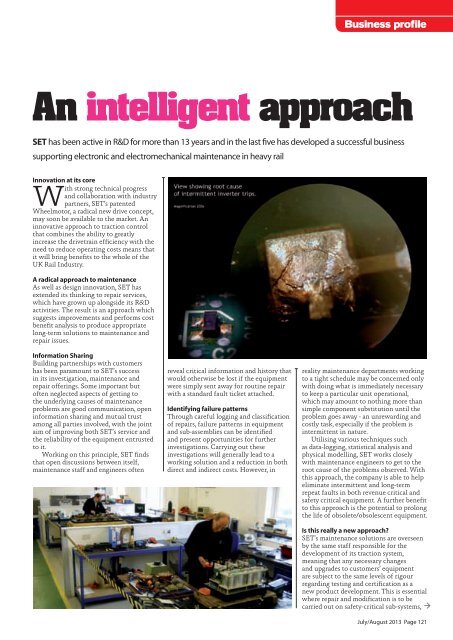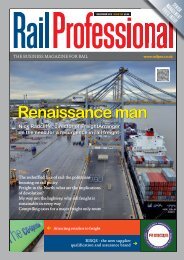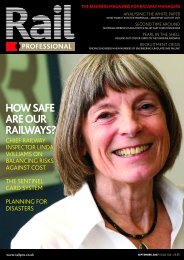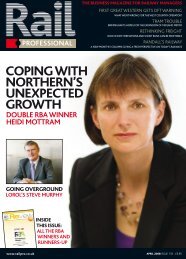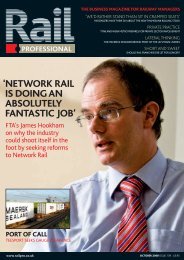View as PDF - Rail Professional
View as PDF - Rail Professional
View as PDF - Rail Professional
Create successful ePaper yourself
Turn your PDF publications into a flip-book with our unique Google optimized e-Paper software.
Business profile<br />
SET h<strong>as</strong> been active in R&D for more than 13 years and in the l<strong>as</strong>t five h<strong>as</strong> developed a successful business<br />
supporting electronic and electromechanical maintenance in heavy rail<br />
Innovation at its core<br />
With strong technical progress<br />
and collaboration with industry<br />
partners, SET’s patented<br />
Wheelmotor, a radical new drive concept,<br />
may soon be available to the market. An<br />
innovative approach to traction control<br />
that combines the ability to greatly<br />
incre<strong>as</strong>e the drivetrain efficiency with the<br />
need to reduce operating costs means that<br />
it will bring benefits to the whole of the<br />
UK <strong>Rail</strong> Industry.<br />
A radical approach to maintenance<br />
As well <strong>as</strong> design innovation, SET h<strong>as</strong><br />
extended its thinking to repair services,<br />
which have grown up alongside its R&D<br />
activities. The result is an approach which<br />
suggests improvements and performs cost<br />
benefit analysis to produce appropriate<br />
long-term solutions to maintenance and<br />
repair issues.<br />
Information Sharing<br />
Building partnerships with customers<br />
h<strong>as</strong> been paramount to SET’s success<br />
in its investigation, maintenance and<br />
repair offerings. Some important but<br />
often neglected <strong>as</strong>pects of getting to<br />
the underlying causes of maintenance<br />
problems are good communication, open<br />
information sharing and mutual trust<br />
among all parties involved, with the joint<br />
aim of improving both SET’s service and<br />
the reliability of the equipment entrusted<br />
to it.<br />
Working on this principle, SET finds<br />
that open discussions between itself,<br />
maintenance staff and engineers often<br />
reveal critical information and history that<br />
would otherwise be lost if the equipment<br />
were simply sent away for routine repair<br />
with a standard fault ticket attached.<br />
Identifying failure patterns<br />
Through careful logging and cl<strong>as</strong>sification<br />
of repairs, failure patterns in equipment<br />
and sub-<strong>as</strong>semblies can be identified<br />
and present opportunities for further<br />
investigations. Carrying out these<br />
investigations will generally lead to a<br />
working solution and a reduction in both<br />
direct and indirect costs. However, in<br />
reality maintenance departments working<br />
to a tight schedule may be concerned only<br />
with doing what is immediately necessary<br />
to keep a particular unit operational,<br />
which may amount to nothing more than<br />
simple component substitution until the<br />
problem goes away - an unrewarding and<br />
costly t<strong>as</strong>k, especially if the problem is<br />
intermittent in nature.<br />
Utilising various techniques such<br />
<strong>as</strong> data-logging, statistical analysis and<br />
physical modelling, SET works closely<br />
with maintenance engineers to get to the<br />
root cause of the problems observed. With<br />
this approach, the company is able to help<br />
eliminate intermittent and long-term<br />
repeat faults in both revenue critical and<br />
safety critical equipment. A further benefit<br />
to this approach is the potential to prolong<br />
the life of obsolete/obsolescent equipment.<br />
Is this really a new approach<br />
SET’s maintenance solutions are overseen<br />
by the same staff responsible for the<br />
development of its traction system,<br />
meaning that any necessary changes<br />
and upgrades to customers’ equipment<br />
are subject to the same levels of rigour<br />
regarding testing and certification <strong>as</strong> a<br />
new product development. This is essential<br />
where repair and modification is to be<br />
carried out on safety-critical sub-systems,<br />
July/August 2013 Page 121


